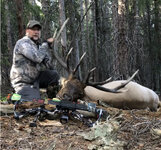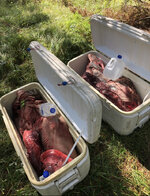jmichaelberg
FNG
- Joined
- Aug 9, 2021
- Messages
- 54
Adult onset elk hunter here. First elk hunt last year but ate tag soup. Had a plan for meat that didn't involve coolers. Next year's hunt, limited local processor capacity and what I'm hearing is either needing to leave elk with processor and have meat shipped home or haul it home or to processor closer to home. If I don't debone the meat, what size and how many coolers would I need for the quarters?


